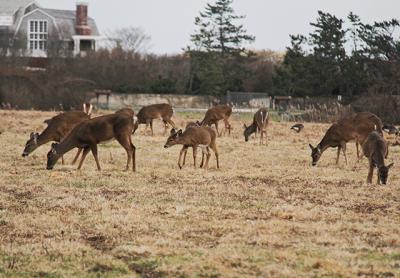Nature Notes: One Big Family

If you looked at The New York Times on Monday, you may have come across an article about saltwater crocodiles in the Philippine Islands and how they attack humans every so often and recently killed a fisherman. Crocodiles eat fish, so do humans. The irony of the story is that in the Philippines crocodiles are protected by law and not hunted because their population had dropped to near zero. In 1918 a female tiger did in several Asian Indians but was not killed outright because tigers, being so rare in that part of India, were also protected.
Newsday recently ran stories about the deer on the eastern part of the Fire Island National Seashore that were becoming so numerous it was decided that the United States Department of Agriculture would be called in to reduce the herd despite the protests of several homeowners who said they enjoyed the deer and they were not a problem. The story reminds us of East Hampton’s deer problem, where culling has occurred in the new millennium more than once, sometimes by very grotesque means. The town’s wildlife committee has been coached by a Department of Agriculture animal control officer and takes his word that deer are a problem, especially to the indigenous flora, some of which are endangered or threatened in New York State.
In the Fire Island case, animal protection organizations sued to prevent the culling and the action was put on hold temporarily, but a judge ruled a few days later that the culling could proceed.
On the one hand, America has protected its wild creatures, not only the big ones like buffaloes, mountain lions, and wolves, but even tiny ones like salamanders, lizards, and butterflies. Such protection on a national scale was assigned to American migratory birds — egrets and the like — as early as 1914, a few years after the last passenger pigeon died. The protection of both rare animals, as well as rare flora, was a big part of Richard Nixon’s term as president, when a slew of national laws protecting the environment were passed by Congress and signed into law. On the other hand, when some of these same fauna and flora are deemed “nuisances,” the U.S. Agriculture Department and various state agencies engage themselves in reducing their populations, sometimes involving the slaughter of not only adult males, but adult females and young as well.
For example, when I worked for the Town of East Hampton and started with others an eastern bluebird nesting box colony at the town airport in the late 1980s I was advised by agents of the Agriculture Department that I should remove the boxes lest a bluebird using them cause a plane crash. The boxes remained and the bluebird population grew as did the number of planes and helicopters coming to and going from the airport without incident.
The Bible treats wild animals better than many modern human populations do. Some of the biblical tales may be just that, such as Noah and his followers loading the wild African animals, both males and females of a species, onto his ark to transport them safely to Mount Ararat across the Mediterranean to save them from a great flood. As children, many of us learned in Sunday school that Jesus loved and respected animals and never preached in his teachings that mass pogroms should be carried out to reduce their populations.
We have become decidedly bipolar in the way we treat our wildlife. On the one hand we go out of our way to protect them, either partially with quotas and seasons, or by an outright 100 percent limitation on killing or injuring them. On the other hand, we kill them outright when we judge that they have become a nuisance, they interfere with vehicular traffic, attack our gardens and landscapes, roost in our trees or on the roof as some turkeys do, attack our cats and toy dogs, or steal their food and rifle through our garbage.
There is a saying: “You can’t teach a hunter not to hunt.” But you can stop killing wildlife for the hell of it! There’s a difference. It’s we who are significantly intruding into their territories and despoiling them, not the other way around.
Some aboriginal populations treat wildlife better than we “modern” societies. Why? Because they relate to wildlife the way they relate to one another: They are all part of the same family.
Larry Penny can be reached via email at [email protected].
